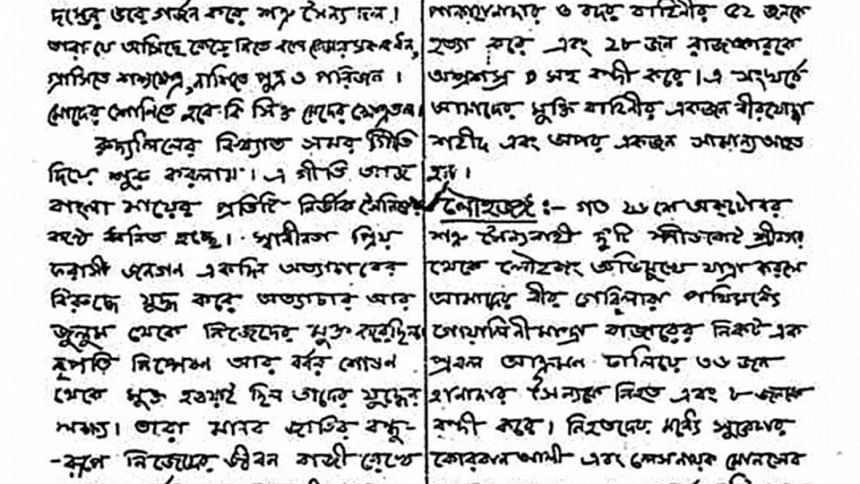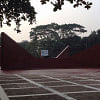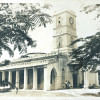Victory Day: Written by hand, driven by heart

October, 1971.
The war waged by the Pakistani occupation army on Bangalees had just entered its eighth month.
Unimaginable brutalities and carnage -- countless deaths, millions displaced and a trail of destruction -- were all over the then East Pakistan, now Bangladesh.
And in the ruins the resistance against the brute Pakistan force was growing in every nook and corner, with thousands taking up the arms and a few others embracing weapons of a different kind to liberate their beloved nation.
One day, a group of young people in a small village in Nawabganj felt the urgent need of a weekly publication to unite the locals against the marauding army's crackdown and killings.
They launched Saptahik Bangladesh to spread the flames of freedom among the people of the greater Bikrampur.
In its 70-day life-span, the weekly mirrored the tumultuous days of 1971 and published local and international news about the Liberation War.
"I cannot explain how difficult it was to publish a newspaper at the time. We were living on our nerves every moment as we published the newspaper," said Mizanur Rahman, a freedom fighter entrusted the task of editing and publishing the weekly from a secret place.
Now 73-year-old, Mizanur, a businessman, talked about the extraordinary episode of bringing out the newspaper with The Daily Star at his Eskaton office.
"I was a teacher and people in the area used to respect me," said Mizanur, who passed matriculation from a school in Kolaroa of Satkhira in 1965 and joined Churain High School in Nawabganj as a teacher in 1969.
The crew involved with the newspaper was at risk of being attacked all the time, he said.
"Besides, collecting the paper and other materials from Dhaka was extremely risky."
His colleague and fellow freedom fighter Abdus Salam took the risk and left for Dhaka on what he now thinks was October 23.
“Salam returned and came to my home the next day with the necessary paper, printing ink, stencils and other materials. It was like we achieved our first victory."
The next challenge was to manage a cyclostyle, a device that makes stencil copies with its small-toothed wheels on a special paper that which serves as a printing form.
Head teacher of the school Shaktipada Chowdhury made the job easy. He gave the school's cyclostyle to the publishers.
The office of the newspaper was set up at a room in Mizanur's rented house. The first issue was published on October 31.
The writers used pseudonyms. Mizanur was Kirti.
The printer's line of the weekly shows "Kirti" as the editor and "Torit" as the printer. The newspaper was published and circulated by "Biplobi Parishad".
Shahidullah Khan was the news editor and Abdul Baten was the chief reporter. Kaikobad and Mohammad Israfil were the sub editors and Rafiqul Islam and Niranjan were reporters.
Each issue had Bangabandhu Sheikh Mujibur Rahman's speeches printed just below the masthead. The paper, except the first four issues, had a sketch of Bangabandhu just beside the masthead and a map of Bangladesh beneath it.
The content mostly depicted the struggle of people, brutalities of the Pak forces, and stories of successful operations and victory of the freedom fighters at different fronts.
The newspaper's editorial, columns, international news and poems were a huge source of inspiration for the common people, he said.
"I used to write a column titled Drishtikon and Mukjodhhar Dairy Theke under my pseudonym."
He became seriously involved in politics in 1965 when he was enrolled in Munshiganj's Haraganga College, a famous institution.
At least 10 teachers of his school would collect news from local and faraway places. Two others were dedicated to collect international news about the war from the radio.

Apart from the Swadhin Bangla Betar Kendra, they used to get reports from BBC, Voice of America and Akashbani.
"We all were young and our emotions ran very high. We used to give a portion of our salary for the expenses of bringing out the newspaper. A number of local people would also donate money sometimes."
Even in those days, the headmaster ensured the regular salary of the teachers every month, he added. "My monthly salary was Tk 160."
Mizanur could not recall the exact amount they would need to bring out the newspaper. But he said one rim of paper would cost around Tk 45 or 50 and a tube of ink Tk 50.
In the initial few weeks, they would print 150 to 200 copies and then increased the publication to around 400 to 500 copies. The highest number of copies that they could bring out was around 1,200, he said.
"Starting from the afternoon, we used to print the newspaper throughout the night."
The price they fixed for each issue hovered between Tk .12 to .25.
"But we used to distribute the paper for free as well, because our main objective was to mobilise a strong public opinion about the atrocities and to lift the morale of the freedom fighters."
Mizanur was the Chhatra League president in Munshiganj subdivision unit and senior vice president of Dhaka district unit in 1967.
"We usually did not verify the reports and ran those that went in favour of freedom fighters. There was practically no scope to cross check those."
One day, they had to flee to Arial Beel with the cyclostyle as they heard that the Pak force was coming to their area.
"That night, we hid in a boat and published the newspaper from there.
"There were many other challenges and concern of losing life, but we continued publishing the newspaper fearlessly," he said, adding that the brief stop-over of Tajuddin Ahmed and his emotional speech in Churain inspired them the most.
The prime minister of the then government in exile in Mujibnagar attended an armed training of the freedom fighters at Churain High School playground on March 27 before heading for Faridpur the next day, said Mizanur.
Mizanur also travelled to Mujibnagar and then to Kolaroa, his birthplace. From there, he went to Bithari of North 24 Parganas district in West Bengal before returning to Nawabganj in mid August to devote himself in organising the war.
The last Saptahik Bangladesh came out on January 8, 1972.


 For all latest news, follow The Daily Star's Google News channel.
For all latest news, follow The Daily Star's Google News channel. 








Comments